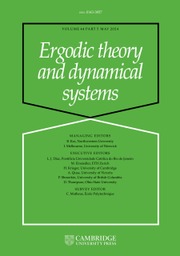No CrossRef data available.
Article contents
Non-leading eigenvalues of the Perron–Frobenius operators for beta-maps
Published online by Cambridge University Press: 29 August 2025
Abstract
We consider the Perron–Frobenius operator defined on the space of functions of bounded variation for the beta-map  $\tau _\beta (x)=\beta x$ (mod
$\tau _\beta (x)=\beta x$ (mod  $1$) for
$1$) for  $\beta \in (1,\infty )$, and investigate its isolated eigenvalues except
$\beta \in (1,\infty )$, and investigate its isolated eigenvalues except  $1$, called non-leading eigenvalues in this paper. We show that the set of
$1$, called non-leading eigenvalues in this paper. We show that the set of  $\beta $ such that the corresponding Perron–Frobenius operator has at least one non-leading eigenvalue is open and dense in
$\beta $ such that the corresponding Perron–Frobenius operator has at least one non-leading eigenvalue is open and dense in  $(1,\infty )$. Furthermore, we establish the Hölder continuity of each non-leading eigenvalue as a function of
$(1,\infty )$. Furthermore, we establish the Hölder continuity of each non-leading eigenvalue as a function of  $\beta $ and show in particular that it is continuous but non-differentiable, whose analogue was conjectured by Flatto, Lagarias and Poonen in [The zeta function of the beta transformation. Ergod. Th. & Dynam. Sys. 14 (1994), 237–266]. In addition, for an eigenfunctional of the Perron–Frobenius operator corresponding to an isolated eigenvalue, we give an explicit formula for the value of the functional applied to the indicator function of every interval. As its application, we provide three results related to non-leading eigenvalues, one of which states that an eigenfunctional corresponding to a non-leading eigenvalue cannot be expressed by any complex measure on the interval, which is in contrast to the case of the leading eigenvalue
$\beta $ and show in particular that it is continuous but non-differentiable, whose analogue was conjectured by Flatto, Lagarias and Poonen in [The zeta function of the beta transformation. Ergod. Th. & Dynam. Sys. 14 (1994), 237–266]. In addition, for an eigenfunctional of the Perron–Frobenius operator corresponding to an isolated eigenvalue, we give an explicit formula for the value of the functional applied to the indicator function of every interval. As its application, we provide three results related to non-leading eigenvalues, one of which states that an eigenfunctional corresponding to a non-leading eigenvalue cannot be expressed by any complex measure on the interval, which is in contrast to the case of the leading eigenvalue  $1$.
$1$.
Information
- Type
- Original Article
- Information
- Copyright
- © The Author(s), 2025. Published by Cambridge University Press


